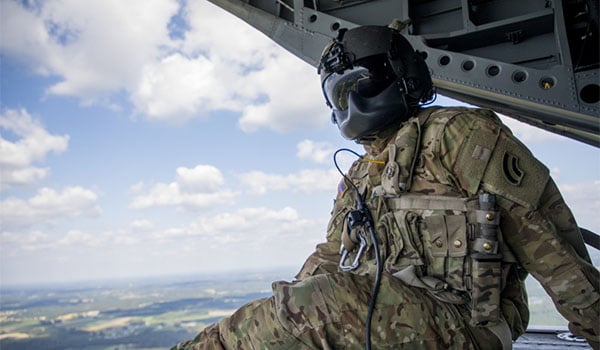
Staff Sgt. Mary Junell, NC Nat. Guard / DVIDS: National GOn Sept. 14, 2018, Hurricane Florence slammed into the Carolina coast as a Category 1 storm, and it sat there.

Staff Sgt. Antonio Rodriguez, with the Maryland National Guard, looks out the rear door of a CH-47 Chinook helicopter on the way to drop off supplies near Lumberton, North Carolina, Sept. 19, 2018. Thirteen states have provided aviation assets in support of the North Carolina National Guard’s mission during Hurricane Florence recovery efforts. (U.S. Army Photo by Staff Sgt. Mary Junell)
Florence quickly downgraded to a tropical storm but moved slow enough, at about 5 mph, that someone could have jogged along in the eye of the storm, staying relatively dry.
The day after Florence’s arrival, Army Aviation Support Facility 1 (AASF1) in Morrisville, North Carolina began receiving Army National Guard aircraft and crews from all over the country to help support recovery efforts.
In addition to North Carolina National Guard’s (NCNG) seven Black Hawk helicopters and two Lakota helicopters available for storm response, 13 states brought helicopters, crews, and mechanics to join in the more than 3,000 N.C. Guardsmen activated in preparation for the massive storm.
“A powerful, damaging hurricane is hours away from our coast,” said N.C. Governor Roy Cooper during a press conference where he announced the mobilization of additional National Guard troops ahead of Florence making landfall and urged citizens to evacuate.
National Guard units from Connecticut, Illinois, Maryland, Minnesota, and Mississippi brought CH-47 Chinooks, the Coast Guard provided 10 helicopters, N.C. State Highway Patrol provided five rotary wing aircraft. The rest of the helicopters were Black Hawks brought by Connecticut, Nebraska, Illinois, Indiana, Maryland, New York, Wisconsin, Oklahoma, Tennessee, Michigan, and New Jersey.
At the height of the storm response the combined aviation assets, including the NCNG, totaled 50 aircraft and approximately 350 Soldiers, Airmen and First Responders, with the majority flying out of the Morrisville flight facility.
“It’s impressive,” said Capt. Curtis Lowe, the daytime flight operations officer with the Kentucky National Guard. “The professionalism of aviation and the aircrews always shines in events like this where there are a lot of variables that we may not be used to seeing in different locations. It’s just well-trained aircrews that are really proficient at their jobs that can show up in any location and accomplish the mission.”
The additional aviation support more than tripled the capabilities of the NCNG making it possible to fly 346 missions, rescuing approximately 441 people, 127 animals and moving more than 685,000 pounds of supplies and equipment. Task Force Aviation also gave leadership a way to survey the damage caused by the storm and transport 685 essential personnel.
On the evening of Sept. 20, a group of National Guard and Coast Guard helicopters and their crews, rescued more than 102 people and 33 pets from Kelly, N.C. as severe flooding hit their small town. The aviators flew out of the AASF1 and Salisbury, N.C., and used night-vision goggles throughout the rescue.
Many of the pilots and crew have been deployed and are accustomed to the busy pace and overnight shifts that come with disaster response operations. For some though, this was their first time resting U.S. citizens.





















